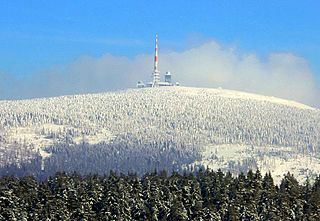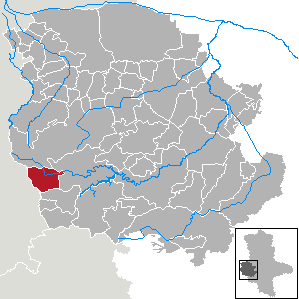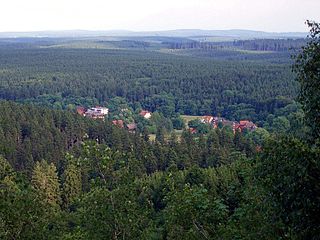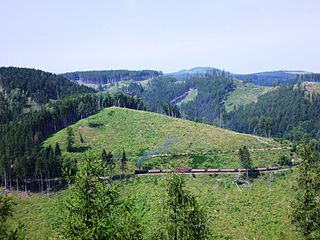
The Ilse valley (German : Ilsetal) is the ravine of the Ilse stream in the northern boundary of the Harz mountain range in Germany. Part of the Harz National Park, it runs from the town of Ilsenburg at the foot of the mountain range up to the source region near the summit of the Brocken massif, the highest mountain of the range. The scenic valley is a popular hiking area.

German is a West Germanic language that is mainly spoken in Central Europe. It is the most widely spoken and official or co-official language in Germany, Austria, Switzerland, South Tyrol in Italy, the German-speaking Community of Belgium, and Liechtenstein. It is also one of the three official languages of Luxembourg and a co-official language in the Opole Voivodeship in Poland. The languages which are most similar to German are the other members of the West Germanic language branch: Afrikaans, Dutch, English, the Frisian languages, Low German/Low Saxon, Luxembourgish, and Yiddish. There are also strong similarities in vocabulary with Danish, Norwegian and Swedish, although those belong to the North Germanic group. German is the second most widely spoken Germanic language, after English.

The Ilse is a river of Saxony-Anhalt and Lower Saxony, Germany.

The Harz is a Mittelgebirge that has the highest elevations in Northern Germany and its rugged terrain extends across parts of Lower Saxony, Saxony-Anhalt, and Thuringia. The name Harz derives from the Middle High German word Hardt or Hart, Latinized as Hercynia. The Brocken is the highest summit in the Harz with an elevation of 1,141.1 metres (3,744 ft) above sea level. The Wurmberg is the highest peak located entirely within the state of Lower Saxony.
As one approaches the steep northwestern edge of the Harz, one can see its more prominent peaks. Between Goslar and Wernigerode, the mountains are especially striking, where their slopes rise steeply from the northern foothills. Between the mountains of the Harz rim run deep gorges. These include those of the Ilse river as well as the parallel valleys of the Oker, Ecker and Bode (Bode Gorge).

Goslar is a historic town in Lower Saxony, Germany. It is the administrative centre of the district of Goslar and located on the northwestern slopes of the Harz mountain range. The Old Town of Goslar and the Mines of Rammelsberg are UNESCO World Heritage Sites.

Wernigerode is a town in the district of Harz, Saxony-Anhalt, Germany. Until 2007, it was the capital of the district of Wernigerode. Its population was 35,041 in 2012.

The Oker is a river in Lower Saxony, Germany, that has historically formed an important political boundary. It is a left tributary of the River Aller, 128 kilometres (80 mi) in length and runs in a generally northerly direction.

Heinrich Heine, the famous German writer, described the Ilse valley with its little river and the rocks of the Ilsestein enthroned above it. In the 1830s, a country road was built from Ilsenburg through the Ilse valley running past the Brocken massif up to Schierke, paid for by Count Henry of Stolberg-Wernigerode (1772–1854). The road made it much easier for tourists to reach the higher mountain regions; today it is closed to public traffic.

Christian Johann Heinrich Heine was a German poet, journalist, essayist, and literary critic. He is best known outside of Germany for his early lyric poetry, which was set to music in the form of Lieder by composers such as Robert Schumann and Franz Schubert. Heine's later verse and prose are distinguished by their satirical wit and irony. He is considered part of the Young Germany movement. His radical political views led to many of his works being banned by German authorities—which, however, only added to his fame. He spent the last 25 years of his life as an expatriate in Paris.
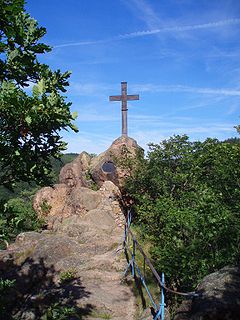
The Ilsestein is a prominent granite rock formation near the town of Ilsenburg in the Harz mountains of central Germany. Offering a scenic view over the Ilse valley to the Brocken massif, the highest mountain of the range, it is today a popular tourist destination.

Schierke is a village and a former municipality in the Harz district, in the German state of Saxony-Anhalt. Since 1 July 2009, it is part of the town Wernigerode. Situated within the Harz mountain range in the valley of the Bode River, at the rim of the Harz National Park, it is mainly a tourist resort, especially for hiking and all kinds of winter sport.
The Brocken (1,141 m above NN) can be climbed from Ilsenburg (250 m above NN) via the 'Heinrich Heine Way' and the Plessenburg lodge on a 15 kilometres (9.3 mi) long hiking trail. In or near the Ilse valley are the following checkpoints on the Harzer Wandernadel hiking network (in downstream order with checkpoint numbers in brackets): Gelber Brink (22), Große Zeterklippe (10), Brockenhaus (9), Stempelsbuche (8), Bremer Hütte (6), Gasthaus Ilsestein (30) and Froschfelsen (5). [1]

Plessenburg is a village in the borough of Ilsenburg in the Harz National Park, in the district of Harz in the German state of Saxony-Anhalt.

The Harzer Wandernadel is a system of hiking awards in the Harz mountains in central Germany. The hiker can earn awards at different levels of challenge by walking to the various checkpoints in the network and stamping his or her passbook to record the visit. With 222 checkpoints in three federal states and across five districts in the Harz and with membership in five figures, the system has gained a following Germany-wide.

The Bremen Hut in the Harz Mountains is a refuge hut and shelter in that part of the Harz National Park lying within the borough of Ilsenburg (Harz) in Harz district in the German state of Saxony-Anhalt.

